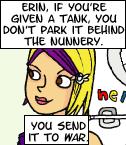delatbabel
Posts: 1252
Joined: 7/30/2006
From: Sydney, Australia
Status: offline

|
(a) this isn't a discussion about AI strategy. That's being worked on entirely separately by Marshall. There have been significant discussions within the test team about that, and hopefully Marshall's taking on board some of those ideas. Hopefully the AI's strategy will get smarter over time, and even if it does need a help getting VPs and PPs on the board, ideally in future it will not be so easy to destroy. This is about guiding the AI's thinking in one particular area, which is whether it should "know" or "guess" the composition of an enemy stack as the basis for its decision making process.
(b) Otherwise I agree with pzgndr. I think that perhaps (a) should be the case for "easy" level AI, (b) should be the case for "medium" level AI, and (c) for "hard" level AI.
Note that in "base mode" EiA all corps strengths, but not their locations, are public knowledge. Hence all players have (b). A lot of gaming groups, especially PBEM ones, tend to go with complete fog of war as a house rule, however. This means most players have (a) unless they are good at guessing their opponents' build strategies (and that builds of ships are always made public) in which case they have (b). Essentially (a) is what is implemented on a player by player basis in EiANW.
The number of corps in an enemy stack is always known, and therefore the AI could make some kind of decision making process inside (a) where it perhaps guessed that all enemy corps were approximately 15 factors, maybe 20 factors for the French and 10 for the Turks and 12 for the Russians, but about 15 on average. If (b) were implemented then it would say "well, I know his army has 80 factors, I can see 10 corps on the board, so I'm going to guess that each corps contains 8 factors on average". If (a) were implemented then the AI would count your factors in each stack.
_____________________________
--
Del
|
 Printable Version
Printable Version











 New Messages
New Messages No New Messages
No New Messages Hot Topic w/ New Messages
Hot Topic w/ New Messages Hot Topic w/o New Messages
Hot Topic w/o New Messages Locked w/ New Messages
Locked w/ New Messages Locked w/o New Messages
Locked w/o New Messages Post New Thread
Post New Thread